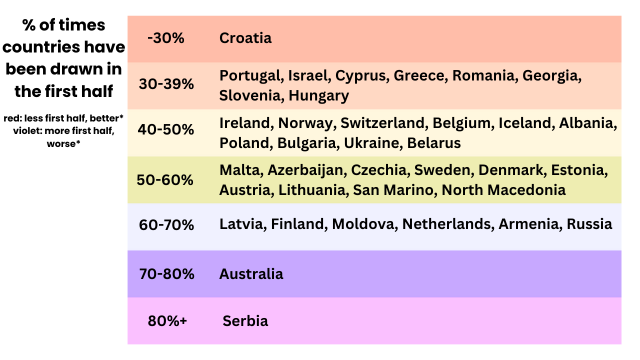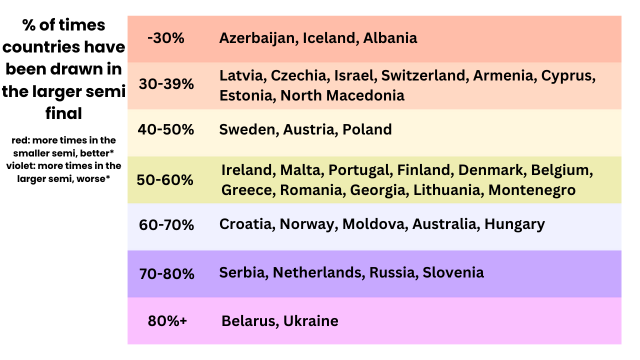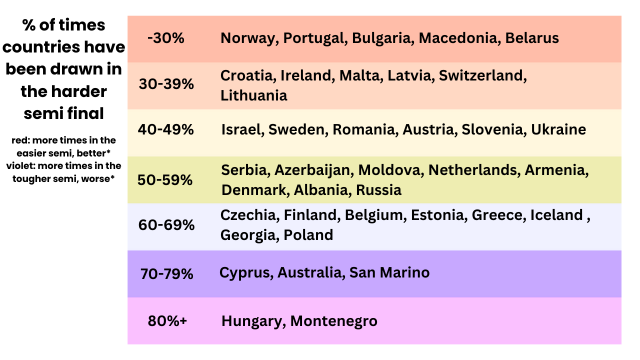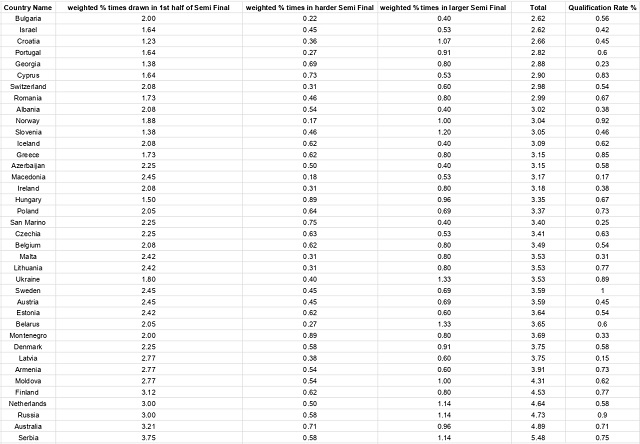On Tuesday 30th January we have Eurovision: The Draw, the new branding for what has been known in recent times as the Allocation Draw. This is the event where delegations get to find out which half of which Semi Final you can be a part of.
At this point in January we have some, but not all, of the songs set to take place in the 2024 Eurovision Song Contest. It can therefore be hard to judge for any viewer if any draw is good or not good.
There are some things that the casual viewer can keep an eye on. One of them is to check out if any of your reliable voting partners are in the Semi Final as yourselves, so they can vote for you. Greece and Cyprus being in the same Semi Final guarantees a top sharing of points, and we’ve seen numerous occasions where Lithuania has scored highly from Ireland and the United Kingdom en route to qualification.
However, there are many other ways to interpret what a good draw is. This article outlines four different things to look out for from a good draw, which nations have benefitted from these criteria through modern Eurovision history, and what that history suggests the impact on your chance of qualification is.
(Details on statistics used are at the end of this article).
When Do You Sing?
You won’t be surprised to hear that one of the first factors in getting a good draw or not is drawing a later slot to sing from. The two Semi Finals are divided up at the Allocation Draw into a first half and a second half. This is announced at this time to help delegations plan flights and accommodation in good time.
It is an advantage to be in the second half of your semi final. In the 26 Eurovision Semi Finals between 2010 to 2023 we study, we see that on average 54.4% of songs that qualify to the Grand Final come from those drawn in the second half. This means that, compared to drawing a 1st half position, drawing the second half can be seen as giving a 19% boost on your qualification chances.
Who has had this opportunity the most? Croatia. Croatia have drawn a 2nd half slot on 8 of their last 11 appearances at Eurovision. Meanwhile their neighbours Serbia are the nation to have had it worst according to this stat, as only 2 of their 12 entries have been drawn into the second half of a Semi Final. However it is Serbia with the better qualification record in this time period, as they have reached the finals compared to Croatia’s three.

The Number of Countries in the Semi Final
We note that this year’s Eurovision Song Contest has 37 participating countries, of which six of them, host country Sweden and the Big 5, are prequalified for the Grand Final. That leaves the remaining 31 nations battling it in two Semi-Finals of 15 and 16 songs, respectively.
It doesn’t take a rocket scientist to realise you want to be in the Semi Final of 15 countries rather than 16. Assuming a random chance of qualification for each entry, being in the smaller semi final gives your nation a 7% higher chance of qualification compared to the bigger show.
Since 2010 there have been eight different occasions when the number of entries differ between the two Semi Finals. Iceland, Azerbaijan and Albania have been luckiest with 6 occasions where they have been in the smaller of the Semi Finals. Slovenia (2 in 8) and Belarus (1 in 6) have had the most misfortune in this regard.
Iceland, Azerbaijan and Albania have combined a qualification success rate of 53% with televoting since 2010, combining Slovenia and Belarus’ qualification also gives a 53% qualification rate.

The Form Book
I take you back to where I was last year watching the allocation draw. I was present at Benidorm Fest and a gathering of the community journalists also in attendance sat together to watch the allocation draw. The gathering from Ireland had their head in their hands watching the lottery play out, as even before we knew most of the songs taking part, the prospect of being in the same Semi Final as Sweden, Norway and a resurgent Finland was not one they saw as much qualification prospects from.
Part of the success of your qualification chances is drawing into a Semi Final with other countries that don’t have stellar track records that qualify almost every year. What we can is we calculate an average qualification rate for the countries taking part in each Semi Final, and then compare the two semi finals. On average there is a difference of roughly 4% in average qualification rate between the “strong” and “weak” Semi Final each year based on this measurement.
Some years have very balanced Semi Finals and some have wide gaps in qualifying percentage. The 2011 Eurovision Song Contest saw the strongest Semi Final on paper using this measurement, over 8% stronger than the other Semi Final. The first Semi Final in Dusseldorf saw seven oft the top ten countries in our qualification data, as well as Turkey, competing against each other in a race for just ten places in the Grand Final.
Norway, alongside North Macedonia and Belarus have had the good fortune of drawing into the weaker Semi Final on most occasions, with Norway only twice in twelve occasions being in the tougher Semi Final. Montenegro and Hungary have a record being drawn in the tougher Semi Final on eight of their nine participations (San Marino is the most of current participants, with 9 out of 12 participations in the tougher Semi Final). The three nations of Norway, North Macedonia and Belarus have combined a qualification rate of 56%, meanwhile Montenegro, Hungary and San Marino lie on 42% from 2010 to the present day.

Do these factors make a difference?
What we plan to do is investigate if these three factors, the strength of your Semi Final, being drawn in the smaller/larger Semi Final, or being drawn in the 1st half or 2nd half, actually makes a difference to your chances of qualification.
Based on the historical data, and, in the case of the larger/smaller Semi Final, the expected % difference in qualification if you draw the smaller show, we believe that these factors have an average difference in qualification of:
- Drawing 2nd half – 18 % advantage
- Drawing the smaller show – 7% advantage
- Drawing the easier semi – average 4% advantage
The following table shows each nation’s historical results on those three criteria to this weighting. Smaller numbers mean that there is a perceived advantage.

Table showing each countries luck at the Allocation Draw since 2010 based on the three criteria in this article
The results of this table show that nations such as Bulgaria, Israel and Croatia are those that can consider themselves fortunate to have received the best Allocation Draw results during their time in the Semi Finals, with Serbia, Australia and Russia those that have had the least luck at the draw.
Now you will be correct in noting that Serbia, Australia and Russia are despite this statistic some of the best nations in Eurovision qualification history, with a combined qualification rate of nearly 80%. In that sense we can conclude that the results of your luck in the draw are not the determining factor in your success in qualifying from a Eurovision Semi Final. Indeed Pearson’s correlation results between our totals and the qualification rate percentage are -0.27. This value implies that actually being more unlucky in the draw may be an advantage to success, though not to any mathematical certainty.
This would obviously be a wrong conclusion to make, we know that competing against less countries and later in the show to be an advantage. What this instead reminds us is that the draw, while important for a few % points here and there, is not more important than your song or the pre-existing voting patterns.
You may fear drawing Ukraine, Norway and Serbia who are on huge Eurovision qualification streaks in the same show as your country, but they still have to pick songs that can challenge the competition to reach the Grand Final.
In Conclusion
The Allocation Draw does not determine the fate of your Eurovision chances alone. Yes, we know there have been years such as last year where one Semi Final had much stronger songs for the scoreboard than the other, but that is something determined by the eventual song quality not by historical successes of each nation. We know that being drawn in the smaller Semi Final or the second half of the show is an advantage, but we also know the size of that advantage isn’t enough to alone be a significant factor on qualification. At best I’d argue getting the 2nd half of the second Semi Final might help that one broadcaster on the cusp of qualifying making it compared to otherwise. For most of the competing countries, if you are good enough you will qualify no matter which Semi Final you draw into.
If you are watching the draw and cheering on the fate of your nation throughout, recall that all of these minor impacts are only going to be an impact if you are in borderline qualification territory. Plus while we know some of the songs for this year, and a few possible tracks in the National Finals, so much is still unknown about what broadcasters will bring to Eurovision this year.
Statistics And Sources
*A note about the statistics we use in this article. All statistics calculated are from a time from 2010 to 2023, as prior to that at allocation draws there was no split between 1st half/2nd half and a wildcard position was in play at the running order draw.
Furthermore when we talk about qualification rates we use the current qualification method of 100% televoting, rather than 50/50 split for most of this era, so this data is more useful to discuss today’s competition. Yes, we use the values quoted for the mean of each country’s televote in 2013 as the most likely result of who would have qualified in the 2013 Semi Finals.
The countries included in the tables have taken part in at least 50% of Semi Finals in this time period.









